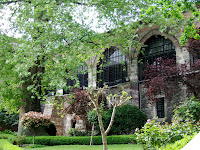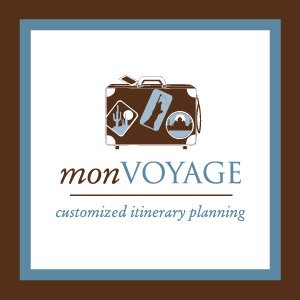Finally, I'm back and have some catching up to do! I was reminded this week that I haven't even mentioned (or at best have done ONLY that) several of the landmark sights of Istanbul: Hagia Sofia, the Blue (Sultanahmnet) Mosque, and Topkapi Palace.

I'll start with Topkapi Palace because it alone can easily occupy you for the entire day. The palace is constructed around several parklike courtyards which were lined with peonies in one case (the last courtyard) and tulips in another (the second), and large trees gracefully shade the crisscrossing walkways of the grounds. The harem quarters require a separate entrance fee, well worth it.
Touring the harem gives you an inkling of court life under the Ottoman sultans--it's really more like the private quarters of the family: different areas were reserved for different members of the household. This could include housing for the eunuchs, the sultan's mother's apartment, the sultan's own rooms; and quarters for the women of his harem, assigned according to rank. He was allowed four wives PLUS four "favorites" chosen from the hundreds of female house servants or slaves, and only with those designated wives or favorites was he involved sexually. Indeed the "harem" consisted of all those women mentioned, but as you can see, relatively few of these concubines were anything but domestic slaves. The decor and detail of these rooms--especially those of the sultan (pic

) and his mother--are pretty incredible. There are intricately painted tiles and stained glass to match, often with the ubiquitous tulip motif.
The kitchen display is a sight to see if you like cooking. When you see the sizes of the pots involved you realize why the kitchen staff had to be huge, the kitchen had to be huge, everything here (like much of the palace) is over-the-top. If you want to see a kitchen like the sultan's in action, I recommend the Hindi film "Jodhaa Akbar" (2008). The emperor Akbar's new wife Jodhaa decides to cook a feast herself (!) and you get a short but great display of all those gigantic vessels being put to use, and the film is set in a similar era and depicts the life of a Muslim ruler.
Other rooms at the palace house some of the sultan's clothing (my favorite being the fur-lined caftans) as well as the incredible jeweled objects displayed in the treasury, from swords to headgear to an 86-carat diamond to thrones. Lots of sparkling goodies.

My other favorite splendor of Topkapi was the Hall of Holy Relics. I don't know how the sultans came to possess these relics but it is surely an indication of the breadth of the Ottoman conquest in Europe and especially the Middle East. From their previous homes in places like Mecca, Medina, and Egypt some of the most important religious relics in the Muslim (and Judeo-Christian) world were brought to the sultan's compound in Istanbul. in those days only the family and very special guests got to see them; today we are all so lucky. Among them: the staff with which Moses' parted the Red Sea; a cooking pot of Abraham; David's sword; John the Baptist's arm and a piece of his skull; Muhammed's sandals and many other of his personal effects, plus a lock of his beard, I think. The atmosphere in these rooms is very sacred and it is obvious that many of the Muslim visitors were praying as they made their way through. The fact that there is a quiet background constant of an imam reciting Koran verses adds to the effect, and this is done 24 hours a day (you can see him near the end of this section of the palace).

Once you make your way to the fourth courtyard, you'll have commanding views of the Golden Horn and the Bosphorus, a lovely spot for a little sit-down, because by the time you get back there you'll surely be tired! If your feet and back are still in good shape, stroll through the nearby Gülhane Park, full of shade and tulips in the springtime. If you're exhausted, go to the park and stretch out on the grass!

The other two biggies, which you should save for another day, are Hagia Sofia and the Blue Mosque. We visited those in succession and could have also added the Museum of Turkish and Islamic Arts as well, but visited it on a different day. Just off the tram stop there is the ancient Hippodrome, now a small park with the remaining ruins--a lovely and lively spot for a picnic lunch.
Across the street you will enter the Blue (Sultanahment) Mosque complex.

It's chock full of people just about all the time. Along one wall are small fountains and spigots for the Muslim men to perform their ablutions (a bit of ritual washing off) before entering. Of course, like visiting any mosque, shoes must be removed and it would be appropriate for women to have their shoulders and head covered, as well as skirt or pants that end below the knee.

Once you're inside, you'll get a neck-ache marveling at the painted dome and really nifty, low-hanging chandeliers.
When you exit the mosque complex, head across another park to Hagia Sofia. This is the granddaddy of European domes, being the first example of such a thing--a giant central dome supported by pillars. Although it partially failed on several occasions and had to be restructured somewhat, it was the largest dome in Europe until Brunelleschi built the Duomo in Florence almost a thousand years later. This Byzantine architectural jewel and landmark inspires architects still today.

It began as a church or basilica -being the seat of the Eastern Christian Church in the 500's, the "Vatican of the East". And what a showpiece it was! People came from far and wide to see its fine marble work and especially the stunning mosaics which graced it for a thousand years. Unfortunately, three days after the Ottoman conquest of Istanbul, it was turned into a mosque; and because Islam does not permit depictions of humans, over those centuries it was used as a mosque, the mosaics were plastered over.

A few have survived, and now that Hagia Sofia does not function in any religious way, only as a museum, there are small areas where you can see some of the recovered and salvaged mosaics.
The last thing I might add to this day is the nearby Museum of Turkish and Islamic Arts, where you can see fine examples of Ottoman calligraphy, plus loads of antique Turkish and Persian carpets, among other things.

It's housed in another former palace with a leafy courtyard.
Next time, I'll acquaint you with our little corner of Istanbul, the Galatasaray section of Beyoglu, our home from home for those nine days.


















































